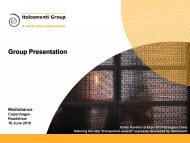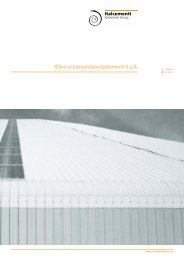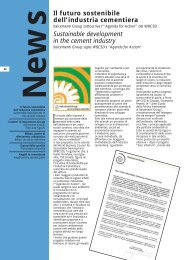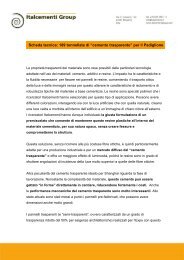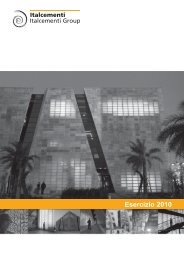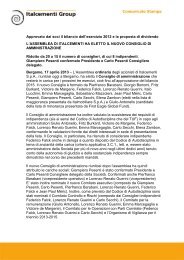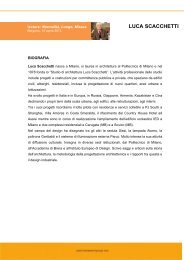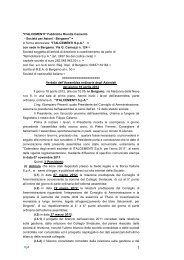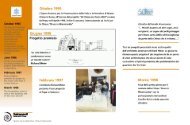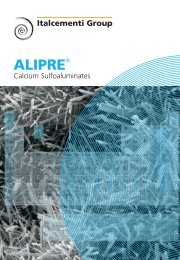La parallasse attraversata dall'uomo Man ... - Italcementi Group
La parallasse attraversata dall'uomo Man ... - Italcementi Group
La parallasse attraversata dall'uomo Man ... - Italcementi Group
Create successful ePaper yourself
Turn your PDF publications into a flip-book with our unique Google optimized e-Paper software.
88<br />
<strong>La</strong> Parallasse.<br />
News<br />
Un'idea di architettura che<br />
legge i fenomeni naturali in<br />
modo dinamico<br />
The Parallax.<br />
An idea of architecture that<br />
reads natural phenomena in a<br />
dynamic manner<br />
Architettura, Edilizia e<br />
Ambiente.<br />
Il 150° anniversario di<br />
Cementos Rezola<br />
Architecture, Building and the<br />
Environment.<br />
Cementos Rezola’s 150th<br />
anniversary<br />
Marocco: Qualità record.<br />
Ciments du Maroc,<br />
primo gruppo cementiero a<br />
ricevere il Premio<br />
Nazionale della Qualità<br />
Morocco: Record Quality.<br />
Ciments du Maroc, the first<br />
cement producer to receive the<br />
National Prize for Quality<br />
Emporium Tower.<br />
Il più prestigioso complesso<br />
residenziale e<br />
commerciale di Bangkok<br />
Emporium Tower.<br />
Bangkok’s Ultimate<br />
Residential and<br />
Commercial Complex<br />
Ambiente e cemento:<br />
l’esperienza di<br />
Ciments Calcia.<br />
Il primo bilancio<br />
ambientale del settore<br />
cemento in Francia<br />
Environment and Cement: the<br />
Ciments Calcia Experience.<br />
The first environmental report<br />
from the French cement industry<br />
<strong>La</strong> <strong>parallasse</strong> <strong>attraversata</strong> dall’uomo<br />
<strong>Man</strong> Crosses the Parallax<br />
Steven Holl<br />
Ètornato ad esporre a<br />
Milano lo scorso marzo,<br />
presso quella stessa<br />
Galleria Aam che aveva<br />
ospitato la sua prima mostra a<br />
livello internazionale vent’anni<br />
fa. Ma quello che allora era<br />
solo un giovane e<br />
promettente architetto è ora<br />
uno dei più grandi e affermati<br />
progettisti del nuovo<br />
millennio. Il suo ritorno<br />
in Italia è stato fortemente<br />
voluto da <strong>Italcementi</strong><br />
nell’ambito di una serie di<br />
manifestazioni culturali che<br />
sotto il nome di “Incontri<br />
Millennium” intendono<br />
avvicinare il grande pubblico<br />
ai più illustri maestri<br />
dell’architettura<br />
contemporanea.<br />
Dopo una riflessione iniziale<br />
dedicata alla lezione lasciataci<br />
in eredità da Alvar Aalto,<br />
“Incontri Millennium”<br />
ha via via percorso i mondi<br />
progettuali e la poetica di<br />
Richard Meier, Enric Miralles,<br />
Dominique Perrault, Santiago<br />
Calatrava e Steven Holl.<br />
(All’interno del sito di <strong>Italcementi</strong><br />
<strong>Group</strong> www.italcementigroup.com<br />
è possibile trovare una rassegna<br />
fotografica relativa all’ultimo evento).<br />
L’inaugurazione della mostra<br />
è stata accompagnata da<br />
un’affollatissima lecture alla<br />
Seconda Facoltà di<br />
Architettura del Politecnico di<br />
Milano, dove sono intervenuti<br />
il rettore del Politecnico<br />
Adriano De Maio, il preside<br />
della Facoltà Antonio<br />
Monestiroli, l’architetto Franco<br />
Raggi per l’Ordine degli<br />
Architetti Milanesi e l’ingegner<br />
Fortunato Zaffaroni, direttore<br />
commerciale di <strong>Italcementi</strong>.<br />
Nel corso dell’incontro<br />
milanese, che ha visto la folta<br />
partecipazione di studenti,<br />
professori universitari,<br />
architetti e imprenditori,<br />
Steven Holl, americano<br />
ma di famiglia norvegese, ha<br />
percorso i venticinque anni di<br />
lavoro della sua architettura,<br />
cominciata da posizioni assai<br />
vicine a quelle della scuola<br />
londinese di Zaha Hadid e di<br />
Rem Koolhaas cui si sono poi<br />
sovrapposte le influenze<br />
dell’architetta lituana Astra<br />
Zarina che fu sua insegnante a<br />
Roma alla fine degli anni ’60.<br />
Oggi Steven Holl, professore<br />
alla Columbia University<br />
e titolare di uno dei più<br />
importanti studi professionali<br />
di New York, è tra coloro<br />
che con più precisa chiarezza<br />
intellettuale e tensione<br />
poetica costruiscono un<br />
cammino innovativo per<br />
l’architettura contemporanea.<br />
Le radici del contesto, della<br />
terra, della realtà naturale,<br />
delle configurazioni e dei limiti<br />
contingenti di ogni suo<br />
progetto, trovano una via<br />
poetica e matematica verso<br />
un’opera che apre nuovi<br />
spazi. E forse un nuovo<br />
orizzonte. Il ruolo di Steven<br />
Holl in questo momento<br />
è proprio quello di dare<br />
possibilità e forme nuove<br />
all’apparire e al formarsi<br />
della natura profonda<br />
dell’architettura. Lo sguardo<br />
è al futuro: ai mille materiali<br />
delle sue possibilità, alla sua<br />
possibile luce, ma il corpo<br />
architettonico è ancorato al<br />
suolo della realtà dello spazio,<br />
della gravità, della luce,<br />
dell’economia, della misura,<br />
dei materiali e dei loro<br />
fenomeni. È in questo gioco<br />
tra realtà e desiderio che i<br />
molti edifici di Steven Holl<br />
hanno trovato il loro posto<br />
e la loro conformazione:<br />
in un’idea di architettura<br />
legata allo spazio e al<br />
movimento della nostra<br />
percezione sensoriale in esso.<br />
Un’idea di architettura che<br />
legge i fenomeni naturali in<br />
modo dinamico, affidando<br />
all’esperienza della <strong>parallasse</strong><br />
la percezione soggettiva di<br />
spazio e luce. Come egli<br />
stesso ha enunciato nel suo<br />
recente libro Parallax, la<br />
<strong>parallasse</strong>, ovvero il<br />
cambiamento della<br />
disposizione delle superfici<br />
che definiscono lo spazio<br />
come risultato del<br />
cambiamento della posizione<br />
dell’osservatore, si trasforma<br />
quando gli assi del movimento<br />
lasciano la posizione<br />
orizzontale. L’idea storica della<br />
prospettiva come volumetrie<br />
conchiuse, basate su uno<br />
spazio orizzontale si apre così<br />
alla dimensione verticale,<br />
l’esperienza architettonica<br />
viene liberata dalla sua<br />
situazione storicamente<br />
racchiusa e gli slittamenti<br />
verticali e obliqui diventano<br />
la chiave di nuove percezioni<br />
spaziali.<br />
Le opere di Steven Holl sono<br />
come pietre, materie<br />
architettoniche che aprono<br />
un discorso innovativo:<br />
dal Museo di Arte<br />
Contemporanea Kiasma<br />
di Helsinki alla Cappella di<br />
Sant’Ignazio a Seattle. Dalle<br />
case costruite negli Stati Uniti<br />
– la Texas Stretto House<br />
di Dallas e la Y House di<br />
Schohary County nello stato<br />
di New York – ai complessi<br />
residenziali di Fukuoka e<br />
Makuhari in Giappone.<br />
Dall’Istituto di Scienza di<br />
Cranbrook nel Michigan e il<br />
Museo d’Arte Bellevue a<br />
Seattle agli Uffici D.E. Shaw a<br />
New York e gli Uffici<br />
Sarphatistraat ad Amsterdam.<br />
Lo stesso si può dire anche per<br />
gli edifici attualmente in<br />
costruzione, dal Residence<br />
2001 per il MIT di Boston<br />
all’ampliamento del Museo<br />
d’Arte Nelson-Atkins di<br />
Kansas City; dalla Facoltà di
Architettura e Architettura del<br />
Paesaggio di Minneapolis al<br />
Teatro Zachary Scott di Austin<br />
in Texas, all’Università di Arte e<br />
Storia dell’Arte dell’Iowa, e ai<br />
progetti per le nuove città,<br />
come la serie di progetti di<br />
“Edge of a City” per gli spazi<br />
urbani di <strong>Man</strong>hattan, Phoenix,<br />
Cleveland, Rochester e Dallas.<br />
Queste opere, come pietre in<br />
una costruzione, formano un<br />
corpo architettonico che porta<br />
avanti la tradizione<br />
dell’architettura<br />
contemporanea da Wright a Le<br />
Corbusier.<br />
Steven Holl (nato a Bremerton, Stato<br />
di Washington, nel 1947) ha aperto<br />
Steven Holl Architects a New York<br />
nel 1976. Si è laureato con lode alla<br />
University of Washington a Seattle.<br />
Ha studiato architettura a Roma nel<br />
1970, e ha fatto dei corsi post-laurea alla<br />
Architectural Association di Londra nel<br />
1976. Nel 1989 il Museo di Arte Moderna<br />
di New York ha presentato<br />
il lavoro di Holl in una speciale mostra,<br />
comprando diversi disegni per la propria<br />
collezione permanente. Nel 1991,<br />
il lavoro di Holl è stato presentato<br />
in una personale al Walker Art Center<br />
di Minneapolis, nella serie intitolata<br />
“Architettura Domani” curata da Mildred<br />
Friedman. Questa mostra si è poi spostata<br />
alla Henry Art Gallery di Seattle e nel<br />
1992–93 è stata in esposizione in tutta<br />
Europa. Nel 1992 Holl ha ricevuto il<br />
National AIA Interiors Award per gli Uffici<br />
di D.E. Shaw & Co. a New York, e nel<br />
1993 il National AIA Honor Award for<br />
Excellence in Design per la Texas Stretto<br />
House di Dallas. Nello stesso anno, Steven<br />
Holl Architects ha vinto il primo premio,<br />
tra 516 partecipanti, per il concorso per<br />
il nuovo Museo di Arte Contemporanea<br />
di Helsinki. L’edificio è stato aperto al<br />
pubblico nel maggio 1998. Tra le sue<br />
onorificenze: i progetti per il Knut<br />
Hamsun Museum di Hamarøy in Norvegia<br />
e il Museo della Città a Cassino in Italia,<br />
che hanno vinto nel 1996 i Progressive<br />
Architecture Awards for Excellence in<br />
Design. <strong>La</strong> Cappella di Sant’Ignazio a<br />
Seattle ha vinto nel 1998 il National AIA<br />
Award for Design Excellence e il Museo<br />
Kiasma di Helsinki ha vinto lo stesso<br />
premio nel 1999.<br />
Tra i riconoscimenti più recenti ci sono<br />
il Progressive Architecture Awards per<br />
il Museo Nelson-Atkins di Kansas City<br />
e la Simmons Hall del MIT<br />
di Boston nel 2000. Il Museo d’Arte<br />
Bellevue, a Seattle, è stato aperto<br />
al pubblico nel gennaio 2001,<br />
ed ha ricevuto il Seattle Award per<br />
l’Architettura.<br />
<strong>La</strong>st March he returned to<br />
exhibit his work at the<br />
Galleria Aam in Milan,<br />
Italy, the same gallery that<br />
hosted his first international<br />
show 20 years ago. But the<br />
man who was then nothing<br />
more than another young and<br />
promising architect is now<br />
recognized as one of the<br />
greatest and most highly<br />
regarded building creators of<br />
the new millennium. His<br />
return to Italy was strongly<br />
promoted by <strong>Italcementi</strong><br />
which through a series of<br />
cultural exhibitions called<br />
“Incontri Millenium”<br />
(Millennium Meetings),<br />
intends to familiarize the<br />
general public with the most<br />
illustrious masters of<br />
contemporary architecture.<br />
After an initial review of the<br />
mastery and instruction left to<br />
us by Alvar Aalto, the<br />
Millennium Meetings series<br />
has painstakingly displayed<br />
the design universes and<br />
poetics of such great<br />
architects as Richard Meier,<br />
Enric Miralles, Dominique<br />
Perrault, Santiago Calatrava<br />
and Steven Holl.<br />
(A collection of photographs<br />
from the latest Millennium<br />
Meeting can be found<br />
on the <strong>Italcementi</strong> <strong>Group</strong> website,<br />
www.italcementigroup.com).<br />
The inauguration of the<br />
Millennium Meetings show<br />
was coupled with a wellattended<br />
lecture in the<br />
Second Faculty of<br />
Architecture at the Politecnico<br />
School of Milan. Speakers<br />
included the Politecnico<br />
School Rector, Adriano De<br />
Maio; the Dean of Faculty,<br />
Antonio Monestiroli; Franco<br />
Raggi under the auspices<br />
of the Order of Milanese<br />
Architects; and Fortunato<br />
Zaffaroni, sales manager<br />
of <strong>Italcementi</strong>.<br />
The student body, university<br />
professors, architects and<br />
businessmen actively<br />
participated in the Milan<br />
meeting as Steven Holl, an<br />
American of Norwegian<br />
descent, presented an<br />
overview of his 25-year career<br />
in architecture. His initial<br />
positions were remarkably<br />
similar to those of the London<br />
school championed by Zaha<br />
Hadid and Rem Koolhaas.<br />
These perspectives were later<br />
superseded by the influence<br />
of Lithuanian architect Astra<br />
Zarina, who was Holl’s<br />
teacher in Rome toward the<br />
end of the 1960s.<br />
Today Steven Holl is a<br />
professor at Columbia<br />
University and owner of one<br />
of the most prominent design<br />
studios in New York. He is<br />
considered a key figure<br />
among the group of modern<br />
architects who, using a<br />
precise intellectual clarity and<br />
poetic tension, are currently<br />
constructing a new and<br />
innovative path for<br />
contemporary architecture.<br />
The roots of context, earth,<br />
natural reality, and of the<br />
configurations and limits<br />
contingent to each of his<br />
projects, find a poetic and<br />
mathematical route toward<br />
an architectural work that<br />
opens up new spaces and<br />
new horizons. Currently<br />
Steven Holl’s role is to bestow<br />
possibility and new form<br />
upon appearance and the<br />
definition of the very nature<br />
of architecture. His gaze is<br />
directed toward the future<br />
and its possibilities for<br />
thousands of materials and its<br />
potential sources of light. Yet<br />
we must acknowledge that<br />
the architectural body is<br />
anchored firmly in the reality<br />
of space, gravity, light,<br />
economy, dimensions,<br />
materials and their relevant<br />
phenomena. And it is within<br />
this interplay between reality<br />
and desire that many of<br />
Steven Holl’s buildings have<br />
found their place and<br />
structure in a notion of<br />
architecture intimately<br />
connected to space and to<br />
the movement of our<br />
sensorial perception within it.<br />
Il Residence<br />
Universitario<br />
del MIT: la strada<br />
piegata, (primo<br />
schema) porosità<br />
orizzontale.<br />
Undergraduate<br />
Residence, MIT:<br />
folded street;<br />
(first scheme)<br />
horizontal<br />
porosity.<br />
89
90 It is an idea of architecture<br />
that reads natural<br />
phenomena in a dynamic<br />
manner, entrusting the<br />
subjective perception of space<br />
and light to the experience<br />
of the parallax. Just as Holl<br />
himself illustrated in his<br />
recent book, Parallax, the<br />
parallax – the change in the<br />
arrangement of surfaces that<br />
define space as a result of the<br />
change in the position of a<br />
viewer – is transformed when<br />
movement axes leave the<br />
horizontal dimension. The<br />
historical idea of perspective<br />
as enclosed volumetrics based<br />
on horizontal space gives way<br />
today to the vertical<br />
dimension. Architectural<br />
experience has been taken<br />
out of its historical closure.<br />
Vertical and oblique slippages<br />
are key to new spatial<br />
perceptions.<br />
Steven Holl’s works are like<br />
stones, architectural materials<br />
that break open innovative<br />
discussion as in the Kiasma<br />
Museum of Contemporary<br />
Art in Helsinki; the Chapel of<br />
St. Ignatius in Seattle; the<br />
houses constructed in the<br />
United States – the Texas<br />
Stretto House in Dallas and<br />
the Y House in the Schohary<br />
County, New York – ; the<br />
Fukuoka and Makuhari<br />
housings in Japan; the<br />
Cranbrook Institute of<br />
Science, Michigan; the<br />
Bellevue Art Museum, Seattle;<br />
the D.E. Shaw Offices in New<br />
York and the Sarphatistraat<br />
Offices in Amsterdam.<br />
The same can be said of the<br />
buildings currently under<br />
construction. For example,<br />
the Undergraduate Residence<br />
2001, MIT, Boston; the<br />
expansion of the<br />
Nelson-Atkins Museum of Art<br />
in Kansas City; the College of<br />
Architecture and <strong>La</strong>ndscape<br />
Architecture in Minneapolis;<br />
the Zachary Scott Theater in<br />
Austin, Texas; and the<br />
University of Iowa Art and Art<br />
History Building.<br />
Also included are his projects<br />
for new cities, like the series<br />
of projects entitled “Edge of a<br />
City” for the urban spaces of<br />
<strong>Man</strong>hattan, Phoenix,<br />
Cleveland, Rochester, and<br />
Dallas.<br />
These architectural works, like<br />
stones in a construction<br />
project, come together to<br />
form a body of architecture<br />
that proudly and admirably<br />
carries forward the tradition<br />
of contemporary architecture<br />
that spans from Wright to<br />
Le Corbusier.<br />
Steven Holl (b. Bremerton, Washington,<br />
1947) established Steven Holl Architects<br />
in New York in 1976. Holl is an honors<br />
graduate of the University of<br />
Washington in Seattle. He studied<br />
architecture in Rome, Italy in 1970, and<br />
did post-graduate work at the<br />
Architectural Association in London in<br />
1976. In 1989, the New York Museum<br />
of Modern Art presented Holl’s work in<br />
a special show, purchasing several<br />
drawings for its permanent collection. In<br />
In alto, dettaglio<br />
dello studio<br />
su spazio e<br />
strutture planari<br />
in acciaio.<br />
A sinistra,<br />
la Cappella<br />
di Sant’Ignazio:<br />
il piazzale<br />
del “campo<br />
di meditazione”.<br />
Lo spazio interno<br />
si irradia nello<br />
spazio del campus.<br />
Above. Enlarged<br />
study of steel<br />
planar space<br />
and structure.<br />
Left. Chapel<br />
of St. Ignatius:<br />
the “thinking field”<br />
forecourt.<br />
Radiance of the<br />
inner space<br />
projected into<br />
campus space.<br />
1991, Holl’s work was featured in a solo<br />
exhibit at the Walker Art Center in<br />
Minneapolis as part of the series entitled<br />
“Architecture Tomorrow, ”whose<br />
curator was Mildred Friedman.<br />
This exhibit was moved to the Henry Art<br />
Gallery in Seattle and in 1992-93 toured<br />
throughout Europe. In 1992 Holl<br />
received the National AIA Interiors<br />
Award for the Offices of D.E. Shaw<br />
& Co. in New York City and in 1993<br />
the National AIA Honor Award for<br />
Excellence in Design for Texas Stretto<br />
House in Dallas. That same year, Steven<br />
Holl Architects was awarded the winning<br />
design among 516 entries in the<br />
competition for the new Museum of<br />
Contemporary Art, Helsinki. The project<br />
opened to the public in May 1998.<br />
Among his honors are the 1996<br />
Progressive Architecture Awards for<br />
Excellence in Design for the Knut<br />
Hamsun Museum in Hamarøy, Norway,<br />
and the Museum of the City in Cassino,<br />
Italy. Holl’s Chapel of St. Ignatius in<br />
Seattle was awarded the 1998 National<br />
AIA Award for Design Excellence and the<br />
Kiasma Museum in Helsinki won the<br />
same award in 1999. The most recent<br />
recognition for Steven Holl Architects’<br />
work includes Progressive Architecture<br />
Awards for the Nelson-Atkins Museum<br />
in Kansas City and the Simmons Hall at<br />
MIT University in Boston in 2000. The<br />
Bellevue Art Museum in Seattle was<br />
opened to the public in January 2001,<br />
and received the Seattle Award for<br />
Architecture.
Architettura, Edilizia e Ambiente<br />
Architecture, Building and the Environment<br />
Cementos Rezola ha<br />
concluso il programma<br />
delle celebrazioni per<br />
il proprio 150° Anniversario<br />
con un convegno sul tema<br />
“Architettura, Edilizia e<br />
Ambiente” nella prestigiosa<br />
cornice del nuovo Palazzo<br />
dei Congressi Euskalduna<br />
di Bilbao, in Spagna.<br />
Quasi 500 partecipanti tra<br />
architetti, prescrittori,<br />
istituzioni, amministrazioni<br />
locali e numerosi clienti hanno<br />
preso parte alla cerimonia<br />
conclusiva delle celebrazioni<br />
per il 150° anniversario di<br />
Cementos Rezola, filiale<br />
d’<strong>Italcementi</strong> <strong>Group</strong> presente<br />
nei Paesi Baschi e nel nord<br />
della Spagna.<br />
Il convegno, incentrato<br />
sull’importanza del ruolo<br />
dell’ambiente in architettura,<br />
urbanistica e edilizia, ha messo<br />
in rilievo la volontà e l’impegno<br />
responsabile di Cementos<br />
Rezola, e dell’intero gruppo<br />
Financiera y Minera in Spagna,<br />
per garantire la continuità delle<br />
proprie attività industriali nel<br />
costante rispetto e nella<br />
migliore integrazione possibile<br />
con l’ambiente circostante.<br />
L’impegno della società è<br />
testimoniato peraltro<br />
dall’ottenimento della<br />
certificazione ISO 14001 per<br />
tutti gli impianti di FyM.<br />
Il folto pubblico presente si è<br />
dimostrato particolarmente<br />
attento ai temi trattati dai<br />
cinque illustri relatori e al<br />
successivo dibattito animato<br />
dal celebre giornalista della<br />
SER, Iñaki Gabilondo.<br />
Dopo la proiezione di un<br />
filmato sul parallelismo tra la<br />
prospettiva visionaria di Fritz<br />
<strong>La</strong>ng in Metropolis (1926) e<br />
un’illustrazione dell’assetto<br />
urbano di questo fine secolo,<br />
gli interventi si sono articolati<br />
intorno ai seguenti temi:<br />
• Il diritto alla città<br />
e la morale cittadina<br />
(riflessione proposta<br />
dal filosofo Javier Sádaba)<br />
• I materiali da costruzione<br />
ed il loro costo<br />
ambientale (Juan Carlos<br />
López Agüí, direttore<br />
dell’Istituto Spagnolo<br />
del Cemento e delle<br />
sue Applicazioni)<br />
• Assetto territoriale<br />
ed urbanistica (Javier<br />
Unzurrunzaga, architetto<br />
ed esperto di urbanistica)<br />
• Urbanistica strategica,<br />
estetica e ambiente<br />
(Juan Miguel Otxotorena,<br />
direttore della Scuola<br />
di Architettura di Navarra)<br />
• <strong>La</strong> responsabilità collettiva<br />
di fronte ad un futuro<br />
eco-compatibile (<strong>Man</strong>uel<br />
Toharia, direttore del Museo<br />
delle Scienze di Valenza).<br />
Tutti gli interventi hanno<br />
saputo combinare<br />
sapientemente contributi di<br />
grande vivacità intellettuale<br />
con riflessioni di utilità pratica.<br />
Dal punto di vista dei materiali<br />
da costruzione, aspetto che<br />
riguarda più direttamente<br />
l’industria del cemento,<br />
l’intervento di Juan Carlos<br />
López Agüí ha proposto di<br />
approfondire il concetto di<br />
costo ambientale comparato<br />
dei materiali nella valutazione<br />
dei mercati pubblici<br />
(infrastrutture, lavori pubblici).<br />
Basata sul concetto di “analisi<br />
del ciclo di vita dei prodotti”<br />
e sull’elaborazione di<br />
“indicatori-chiave delle<br />
performance”, la valutazione<br />
quantitativa dei materiali con<br />
riferimento all’“impatto<br />
ambientale del loro ciclo<br />
di vita”, sembra in grado<br />
di imporsi con naturalezza nel<br />
settore edilizio. Non sorprende<br />
quindi constatare che il ciclo<br />
del cemento gode di un reale<br />
vantaggio competitivo<br />
in materia.<br />
■■■■■■<br />
Cementos Rezola<br />
concluded its 150th<br />
Anniversary<br />
celebrations with a<br />
conference on the theme<br />
of “Architecture, Building<br />
and the Environment,” held<br />
Un’immagine della cerimonia conclusiva<br />
delle celebrazioni per<br />
il 150° anniversario di Cementos Rezola.<br />
at the new, prestigious<br />
Euskalduna Convention<br />
Center in Bilbao, Spain.<br />
Nearly 500 participants<br />
including architects, specifiers,<br />
administrative and institutional<br />
representatives as well as<br />
numerous clients were present<br />
at the closing conference<br />
celebrating Cementos Rezola’s<br />
150th anniversary. Cementos<br />
Rezola is the cement business<br />
unit of the <strong>Italcementi</strong> <strong>Group</strong>,<br />
operating in the Basque<br />
country and the north of<br />
Spain. The convention focused<br />
on the role of the environment<br />
in architecture, urban planning<br />
and construction. It revealed<br />
Cementos Rezola’s<br />
commitment – shared by all<br />
the Financiera y Minera<br />
<strong>Group</strong>’s businesses in Spain –<br />
A picture of the closing ceremony<br />
celebrating Cementos Rezola’s 150th<br />
anniversary.<br />
to a responsible approach<br />
regarding not only the<br />
continuation of its business<br />
activity, but also the best<br />
possible integration into the<br />
immediate environment. This<br />
is further demonstrated by the<br />
recent ISO 14001 certification<br />
of all the FyM plants.<br />
The gathering of professionals<br />
was particularly attuned to the<br />
themes developed by five<br />
excellent lecturers and to the<br />
ensuing debate moderated by<br />
the prestigious SER journalist,<br />
Iñaki Gabilondo.<br />
Following a video presentation<br />
comparing Fritz <strong>La</strong>ng’s<br />
visionary futurology in<br />
Metropolis (1926) to an<br />
illustration of the urban<br />
planning of this fin de siècle,<br />
discussion centered around the<br />
91
following main themes:<br />
• The right to the city and<br />
civil morality (considerations<br />
proposed by the philosopher<br />
Javier Sádaba)<br />
• Construction materials<br />
and their environmental<br />
costs (by Juan Carlos<br />
López Agüí, director<br />
of the Spanish Institute<br />
of Cement and its<br />
Applications)<br />
• Regional and urban<br />
planning (by Javier<br />
Unzurrunzaga, architect<br />
and urban planning<br />
consultant)<br />
• Strategic, esthetic<br />
and environmental urban<br />
planning (by Juan Miguel<br />
Otxotorena, director<br />
of the Architecture School<br />
of Navarra)<br />
• Our collective<br />
responsibility regarding<br />
an environmentally viable<br />
future (by <strong>Man</strong>uel<br />
Toharia, director of the<br />
Museum of Science<br />
in Valencia).<br />
Each presentation combined<br />
brilliant intellectual<br />
contributions with useful<br />
food for thought.<br />
From the standpoint<br />
of construction materials,<br />
an aspect that concerns the<br />
cement industry most directly,<br />
Juan Carlos López Agüí’s talk<br />
proposed an in-depth<br />
examination of the concepts<br />
of the comparative<br />
environmental cost of<br />
construction materials in the<br />
evaluation of public markets<br />
(infrastructures, public works).<br />
Based on an “analysis of the<br />
product life cycle” and on<br />
the elaboration of<br />
“key performance<br />
indicators,” the quantitative<br />
evaluation of materials<br />
with regard to the<br />
“environmental impact<br />
of their life cycle” becomes<br />
a natural consideration<br />
in construction.<br />
Therefore, it comes as<br />
no surprise to most people<br />
that the cement industry<br />
can gain a real competitive<br />
advantage from this type<br />
of life cycle analysis.<br />
92<br />
Emporium Tower: il più prestigioso complesso<br />
residenziale e commerciale di Bangkok<br />
Emporium Tower: Bangkok’s Ultimate Residential<br />
and Commercial Complex<br />
Tower è un<br />
edificio polifunzionale di<br />
L’Emporium 43 piani con una<br />
superficie totale di oltre<br />
250.000 mq, realizzato dalla<br />
City Realty Co. Ltd. a un costo<br />
complessivo di oltre 6,5<br />
miliardi di Baht (circa 160<br />
milioni di euro).<br />
<strong>La</strong> Torre è situata vicino a un<br />
parco pubblico nel centro di<br />
Bangkok e si compone di una<br />
base di sette piani, occupata<br />
da spazi commerciali, una<br />
sezione di 19 piani adibita<br />
a uffici e 380 unità residenziali<br />
di lusso, nei 17 piani alti,<br />
servite da parcheggi coperti<br />
per 2.000 posti auto.<br />
Asia Cement (<strong>Italcementi</strong><br />
<strong>Group</strong>) ha fornito oltre<br />
130.000 metri cubi di<br />
calcestruzzo per la costruzione<br />
di questo Emporium Tower,<br />
iniziata nel 1993.<br />
Ciascun elemento costitutivo<br />
di questo complesso<br />
multifunzionale si è rivelato<br />
un vero e proprio successo<br />
ed è diventato un modello di<br />
riferimento nel proprio settore.<br />
Il Centro Commerciale<br />
Emporium, molto apprezzato<br />
fin dalla sua inaugurazione nel<br />
1997, è stato acclamato come<br />
il centro commerciale più alla<br />
moda e di maggior prestigio<br />
della capitale tailandese. Meno<br />
di due anni più tardi e in un<br />
breve lasso di tempo dopo la<br />
loro inaugurazione, gli Uffici<br />
Emporium sono riusciti ad<br />
attrarre l’attenzione di grandi<br />
società nazionali e<br />
internazionali che ne hanno<br />
affittato tutti gli spazi. Le Suites<br />
Emporium, d’altra parte, sono<br />
ormai riconosciute come gli<br />
appartamenti più eleganti e<br />
meglio serviti di tutta Bangkok<br />
grazie alle raffinate decorazioni<br />
d’interni, le viste panoramiche,<br />
la posizione strategica, la<br />
cortesia del personale di<br />
servizio e il facile accesso alle<br />
amenità locali: tutte qualità<br />
che nel loro insieme<br />
contribuiscono a definire il<br />
nuovo standard delle residenze<br />
di lusso dell’intera città.<br />
■■■■■■<br />
Emporium Tower is a<br />
43-story, multi-purpose<br />
building with a total floor<br />
space of over 250,000 sq. m.<br />
It was developed by City Realty<br />
Co. Ltd. at a total cost of over<br />
6.5 billion Baht (about 160<br />
million euros).<br />
The Tower is located next to a<br />
public park in central Bangkok<br />
and consists of a 7-story<br />
shopping podium, a 19-story<br />
office area, 380 executive<br />
serviced apartments on the<br />
top 17 floors, and indoor<br />
garages accommodating<br />
approximately 2,000 vehicles.<br />
Asia Cement (<strong>Italcementi</strong><br />
<strong>Group</strong>) supplied over 130,000<br />
cubic meters of concrete<br />
for the construction of this<br />
Emporium Tower which<br />
began in 1993.<br />
Every component of this<br />
multi-purpose development<br />
has turned out to be very<br />
successful and has become<br />
a benchmark in its business<br />
sector. The Emporium<br />
Shopping Center has been<br />
highly acclaimed since it<br />
opened in 1997 as Bangkok’s<br />
trendiest and most successful<br />
retail center.<br />
Less than two years later, the<br />
Emporium Office was able to<br />
attract and rent its entire office<br />
space to local and international<br />
corporations shortly after its<br />
opening. And the Emporium<br />
Suites are now widely<br />
considered to be Bangkok’s<br />
finest serviced apartments<br />
where tasteful interior<br />
decorations, panoramic views,<br />
strategic location, courteous<br />
Veduta generale dell’Emporium Tower<br />
nel complesso urbano.<br />
service, and easy access<br />
to local amenities all combine<br />
to set new standards<br />
of luxurious executive living<br />
for the entire city.<br />
Overall view of the Emporium Tower<br />
in its urban setting.
Marocco: Qualità record<br />
Morocco: Record Quality<br />
<strong>La</strong> cupola, simbolo<br />
dell’impianto di<br />
Ciments du Maroc<br />
a Safi.<br />
The dome, the<br />
symbol of Ciments<br />
du Maroc’s Safi<br />
plant.<br />
Ciments du Maroc è il<br />
primo gruppo cementiero<br />
marocchino ad avere<br />
ottenuto il Premio Nazionale<br />
della Qualità, nella categoria<br />
Grandi Imprese, edizione 2000,<br />
organizzato in associazione con<br />
l’UMAQ (Unione Marocchina<br />
per la Qualità) ed il Ministero<br />
dell’Industria, del Commercio,<br />
dell’Energia e delle Miniere.<br />
Questo riconoscimento viene a<br />
coronare i lunghi anni di lavoro<br />
degli uomini della società e il<br />
loro costante impegno nella<br />
ricerca della qualità.<br />
Ciments du Maroc, filiale<br />
d’<strong>Italcementi</strong> <strong>Group</strong> svolge la<br />
propria attività nel settore dei<br />
materiali da costruzione<br />
attraverso le cementerie di<br />
Agadir, Safi e Marrakech<br />
(cemento e clinker),<br />
e la controllata Bétomar<br />
con numerose centrali<br />
di betonaggio e cave diffuse<br />
su tutto il territorio nazionale.<br />
Ciments du Maroc produce e<br />
commercializza attualmente<br />
circa 2.500.000 tonnellate di<br />
cemento l’anno, di cui 410.000<br />
tonnellate destinate<br />
all’esportazione, e vanta una<br />
capacità produttiva di<br />
3.000.000 di tonnellate annue<br />
di cemento. Grazie alla politica<br />
globale di <strong>Italcementi</strong> <strong>Group</strong>,<br />
Ciments du Maroc è divenuto il<br />
secondo gruppo cementiero del<br />
Marocco e ha avuto un peso<br />
considerevole nei risultati<br />
consolidati del Gruppo. Nel<br />
2000, il fatturato di Ciments du<br />
Maroc (con il consolidamento<br />
di Bétomar) è salito a 1.696<br />
milioni di dirham (175 milioni<br />
di euro), ed il risultato netto<br />
è ammontato a 304 milioni<br />
di dirham (31 milioni di euro).<br />
Storia della Qualità<br />
Organizzazione Qualità (1992)<br />
Innalzamento del sistema<br />
qualità a un alto livello della<br />
funzione tecnica. In ogni unità<br />
produttiva è stata introdotta la<br />
figura del responsabile qualità<br />
che garantisce il controllo ed il<br />
follow-up della qualità dei<br />
prodotti.<br />
PACT (1995)<br />
Introduzione di piani d’azione<br />
e di concertazione triennali,<br />
i PACT, che definiscono per ogni<br />
settore di attività le linee<br />
d’azione prioritarie da realizzare<br />
in un lasso di tempo di tre anni,<br />
sulla base di una diagnostica<br />
generale e di un’indagine sulle<br />
esigenze della clientela.<br />
Certificazione dei prodotti (1995)<br />
da parte del Ministero del<br />
Commercio e dell’Industria<br />
(Marchio NM). <strong>La</strong> qualità dei<br />
prodotti viene costantemente<br />
e regolarmente controllata<br />
dal servizio qualità dei singoli<br />
impianti e da un organismo<br />
indipendente di verifica che<br />
sottopone le proprie conclusioni<br />
semestrali allo SNIMA (Servizio<br />
di Standardizzazione<br />
dell’Industria Marocchina).<br />
Qualità Totale:<br />
Gruppi di progresso (1996)<br />
Costituzione nell’ambito<br />
delle singole unità produttive<br />
dei cosiddetti gruppi per<br />
il progresso con il compito<br />
di evidenziare eventuali<br />
disfunzioni e avviare<br />
le conseguenti azioni<br />
di miglioramento.<br />
Certificazione Sistema<br />
ISO 9002 (1997)<br />
SAFI Agosto 1998<br />
AGADIR Maggio 1999<br />
MARRAKECH Aprile 2001<br />
Premio d’Incoraggiamento<br />
del Premio Nazionale della Qualità<br />
(1999)<br />
Premio Nazionale della Qualità<br />
(2000)<br />
Ciments du Maroc ha fatto<br />
della qualità un principio di<br />
management definendo la<br />
politica qualità ed i suoi<br />
principali orientamenti e<br />
fornendo tutti gli strumenti<br />
umani e materiali necessari per<br />
la sua messa in opera.<br />
Questa politica globale ha<br />
consentito a Ciments du Maroc<br />
di migliorare le proprie<br />
performance, soddisfare<br />
e fidelizzare la propria clientela<br />
e conquistare all’esportazione<br />
mercati prima difficilmente<br />
accessibili ai cementieri<br />
marocchini.<br />
■■■■■■<br />
Ciments du Maroc is the<br />
first Moroccan cement<br />
producer to receive the<br />
National Prize for Quality in the<br />
<strong>La</strong>rge Enterprises category for<br />
the year 2000. The prize is<br />
organized jointly by the UMAQ<br />
( Moroccan Union for Quality)<br />
and the Ministry of Industry,<br />
Commerce, Energy and Mining.<br />
This award recognizes many<br />
years of hard work and<br />
dedication by the employees<br />
of the company as well as other<br />
ongoing quality program<br />
efforts. Ciments du Maroc, a<br />
subsidiary of <strong>Italcementi</strong> <strong>Group</strong>,<br />
operates in the construction<br />
materials sector through the<br />
cement plants in Agadir, Safi<br />
and Marrakech (cement and<br />
clinker), as well as several<br />
concrete batching units and<br />
quarries (Bétomar) throughout<br />
the kingdom. Ciments du<br />
Maroc produces and sells about<br />
2,500,000 metric tons of<br />
cement yearly, 410,000 of<br />
which are exported to foreign<br />
markets. The company boasts a<br />
production capacity of<br />
3,000,000 metric tons per year.<br />
<strong>Italcementi</strong> <strong>Group</strong>’s global<br />
policy has enabled Ciments du<br />
Maroc to become Morocco’s<br />
second-largest cement<br />
company and to contribute<br />
significantly to the <strong>Italcementi</strong><br />
<strong>Group</strong>’s consolidated results.<br />
In 2000, Ciments du Maroc’s<br />
net sales (including Bétomar)<br />
grew to 1,696 million dirhams<br />
(175 million euros), with a net<br />
profit of 304 million dirhams<br />
(31 million euros).<br />
The History of Quality<br />
Quality Organization (1992)<br />
The quality system is raised<br />
to a high level of the technical<br />
functions. A quality manager<br />
is assigned to each production<br />
unit and is directly responsible<br />
for the quality control and<br />
follow-up.<br />
PACT (1995)<br />
Concerted three-year action<br />
plans known as PACTs are<br />
instituted. These plans define<br />
the priority actions to be<br />
conducted in all areas over<br />
the subsequent three years,<br />
based on a general evaluation<br />
and an attentive inquiry into<br />
customer satisfaction.<br />
Product Certification (1995)<br />
Product Certification is<br />
administered by the Ministry<br />
of Commerce and Industry<br />
(the NM seal). Product quality<br />
is constantly monitored by<br />
each plant’s quality<br />
department as well as by<br />
an unaffiliated third-party<br />
monitoring group that<br />
submits its conclusions<br />
semi-annually to the SNIMA<br />
(Service of Standardization<br />
of Moroccan Industry).<br />
Total Quality: Progress <strong>Group</strong>s<br />
(1996)<br />
Progress <strong>Group</strong>s are<br />
established within the plants<br />
in order to deal with existing<br />
problems and to recommend<br />
improvement initiatives.<br />
ISO 9002 System Certification (1997)<br />
SAFI August 1998<br />
AGADIR May 1999<br />
MARRAKECH April 2001<br />
Encouragement Prize in the<br />
National Quality Awards (1999)<br />
National Prize for Quality (2000)<br />
The key points of the<br />
<strong>Italcementi</strong> <strong>Group</strong> quality<br />
program have become a<br />
fundamental part of the<br />
company’s management<br />
strategy, and by the same<br />
token management has<br />
provided for the human and<br />
material resources necessary<br />
for its development.<br />
This global policy has allowed<br />
Ciments du Maroc – all while<br />
improving its performance –<br />
to fully satisfy and gain the<br />
loyalty of its customers, and<br />
to conquer export markets<br />
that until now proved difficult<br />
for Moroccan cement<br />
manufacturers to penetrate.<br />
93
Come coniugare ambiente e cemento:<br />
l’esperienza di Ciments Calcia<br />
Mixing Environment and Cement:<br />
the Ciments Calcia Experience<br />
94<br />
<strong>Group</strong> è da<br />
sempre impegnato ad<br />
“<strong>Italcementi</strong> aumentare il valore del<br />
proprio gruppo, delle proprie<br />
aziende, dei propri prodotti e<br />
dei propri servizi, nonché la<br />
capacità operativa del proprio<br />
personale operando nel pieno<br />
rispetto degli standard<br />
ecologici e ambientali. Con la<br />
convinzione quindi che la<br />
tutela dell’ambiente sia un<br />
impegno per le maggiori<br />
società ed una componente<br />
fondamentale nella gestione<br />
d’impresa”. Queste parole<br />
sono tratte da Vision il<br />
documento che raccoglie le<br />
linee guida, la visione comune<br />
e gli obiettivi di <strong>Italcementi</strong><br />
<strong>Group</strong>. <strong>La</strong> Vision rappresenta<br />
l’ambizione del gruppo per il<br />
futuro. <strong>La</strong> dimensione<br />
mondiale di <strong>Italcementi</strong> <strong>Group</strong><br />
e le sue attività intimamente<br />
connesse al territorio<br />
comportano anche un preciso<br />
impegno verso il rispetto<br />
dell’ambiente.<br />
<strong>Italcementi</strong> <strong>Group</strong> intende<br />
seguire una politica produttiva<br />
che permetta un rapporto<br />
ideale con l’ambiente durante<br />
tutto l’arco delle diverse<br />
fasi di produzione e<br />
commercializzazione dei suoi<br />
prodotti.<br />
L’atteggiamento dell’azienda<br />
non si limita infatti all’adozione<br />
di norme particolarmente<br />
restrittive sull’inquinamento,<br />
ma esplora strade nuove per<br />
raggiungere un equilibrio tra<br />
sfruttamento delle risorse e<br />
impoverimento del pianeta.<br />
In tal senso, va segnalata<br />
l’adesione al “World Business<br />
Council for Sustainable<br />
Development” (WBCSD),<br />
organismo al quale aderiscono<br />
150 gruppi internazionali<br />
che condividono gli stessi<br />
principi in merito allo<br />
“sviluppo sostenibile” che mira<br />
al soddisfacimento dei bisogni<br />
presenti salvaguardando le<br />
esigenze delle future<br />
generazioni e che si basa su<br />
presupposti sociali, economici<br />
e di tutela ambientale.<br />
Con altri dieci gruppi<br />
cementieri internazionali,<br />
<strong>Italcementi</strong> <strong>Group</strong> partecipa,<br />
con il supporto del WBCSD ad<br />
un programma specifico per<br />
l’industria del cemento.<br />
<strong>La</strong> produzione del cemento<br />
e l’ambiente<br />
<strong>La</strong> produzione del cemento<br />
è una delle necessità vitali di<br />
qualsiasi Paese industrializzato,<br />
allo stesso modo in cui nessun<br />
Paese può fare a meno della<br />
produzione siderurgica, della<br />
raffinazione del petrolio, della<br />
produzione della carta,<br />
dell’industria chimica e di<br />
numerose altre attività<br />
industriali di base, attività che<br />
l’immaginario collettivo<br />
considera con sospetto,<br />
basandosi spesso unicamente<br />
su una percezione epidermica<br />
di rischio ambientale. È pur<br />
vero che tale comune<br />
percezione è l’eredità di tempi<br />
passati, quando le esigenze di<br />
industrializzazione e di<br />
raggiungimento di soglie<br />
minime di benessere sociale<br />
ponevano in secondo piano le<br />
problematiche ambientali<br />
connesse con certe necessarie<br />
attività produttive. Da una<br />
quindicina d’anni, tuttavia,<br />
l’Europa occidentale ha<br />
cambiato radicalmente visione,<br />
istituendo norme legislative<br />
precise e severe a salvaguardia<br />
dell’ambiente, che ha assunto<br />
un ruolo primario in tutte le<br />
attività industriali. Le grandi<br />
aziende che operano a livello<br />
nazionale e internazionale<br />
hanno ormai permeato ogni<br />
loro attività di una<br />
consapevolezza ambientale più<br />
o meno marcata, resa<br />
necessaria dalla mutata<br />
sensibilità e dalla diversa scala<br />
di valori che le popolazioni<br />
hanno adottato da qualche<br />
anno a questa parte,<br />
in conseguenza del livello<br />
di benessere individuale<br />
raggiunto.<br />
<strong>Italcementi</strong> <strong>Group</strong> non<br />
fa eccezione, anzi si pone<br />
all’avanguardia nel drappello<br />
di aziende europee<br />
maggiormente motivate per<br />
la salvaguardia dell’ambiente,<br />
pur operando, come si è detto,<br />
in un settore industriale<br />
potenzialmente critico.<br />
Le testimonianze concrete<br />
della cultura ambientale<br />
di <strong>Italcementi</strong> <strong>Group</strong> sono<br />
numerose e il bilancio<br />
ambientale di Ciments Calcia<br />
è una di queste.<br />
Il Bilancio Ambientale di<br />
Ciments Calcia<br />
Ciments Calcia, filiale francese<br />
di <strong>Italcementi</strong> <strong>Group</strong>, ha<br />
pubblicato il suo primo bilancio<br />
ambientale (il primo in Francia<br />
per quanto riguarda l’industria<br />
del cemento) e lo scorso<br />
13 dicembre 2000 ha invitato<br />
l’associazione di tutela<br />
dell’ambiente<br />
“Amici della Terra” affinché<br />
ne desse una valutazione critica<br />
alla presenza di 150 delegati tra<br />
cui politici, industriali,<br />
rappresentanti di associazioni<br />
e di amministrazioni locali.<br />
Questa iniziativa, che ha<br />
rappresentato una vera<br />
Copertina<br />
del bilancio<br />
ambientale<br />
di Ciments Calcia.<br />
Front cover of the<br />
Ciments Calcia’s<br />
environmental<br />
report.<br />
e propria “prima” nel settore<br />
dell’industria cementiera,<br />
intendeva chiarire le scelte<br />
aziendali riguardanti le<br />
informazioni riportate in questo<br />
tipo di bilancio e ha inoltre<br />
costituito per Ciments Calcia un<br />
ulteriore passo avanti nella sua<br />
politica di tutela dell’ambiente e<br />
di trasparenza sulle proprie<br />
attività industriali.<br />
Ciments Calcia ha rivolto<br />
il proprio invito agli<br />
“Amici della Terra” in ragione<br />
del lavoro svolto da questa<br />
associazione per l’elaborazione<br />
di un modello di report<br />
ambientale destinato alle<br />
aziende: l’obiettivo era quello di<br />
evitare che i bilanci ambientali<br />
assomigliassero a una sorta di<br />
opuscoli pubblicitari dal<br />
contenuto lacunoso.<br />
Questo lavoro degli “Amici<br />
della Terra” è stato compiuto in<br />
collaborazione con vari<br />
interlocutori, tra i quali Ciments<br />
Calcia, e si basa sull’analisi di<br />
120 bilanci ambientali di varie<br />
aziende provenienti da quattro<br />
Paesi: Francia, Italia, Belgio,<br />
Regno Unito.
Perché un Bilancio<br />
Ambientale?<br />
L’industria del cemento è solita<br />
evocare l’immagine di una<br />
nuvola di polvere bianca<br />
sprigionata da grossi impianti<br />
industriali o da cave che<br />
deturpano il paesaggio.<br />
Si tratta, indubbiamente,<br />
di un’industria pesante con un<br />
forte impatto ambientale. E, se<br />
si vuole che questa industria<br />
esista ancora fra vent’anni,<br />
diventa indispensabile condurre<br />
una politica ambientale di alta<br />
qualità in grado di rispondere<br />
ad una legittima<br />
preoccupazione emergente,<br />
in coerenza con le aspirazioni<br />
degli operatori del settore<br />
e in generale, dell’insieme<br />
delle popolazioni che vivono<br />
nei territori dove sorgono<br />
gli impianti.<br />
Eppure, oggi, nei fatti,<br />
l’immagine spesso negativa<br />
dell’industria del cemento fa<br />
parte del passato. Negli ultimi<br />
anni sono stati compiuti sforzi<br />
considerevoli e la salvaguardia<br />
dell’ambiente è diventata una<br />
delle priorità manageriali<br />
dell’azienda allo stesso livello<br />
delle risorse umane, della<br />
sicurezza e della qualità.<br />
L’impegno ambientale di<br />
Ciments Calcia comprende<br />
diversi elementi:<br />
modernizzazione delle<br />
installazioni; predisposizione di<br />
sistemi di gestione ambientale<br />
e certificazione ISO 14001 per<br />
ogni sito produttivo;<br />
formazione del personale delle<br />
cementerie sugli impatti della<br />
produzione; creazione di<br />
strumenti di comunicazione<br />
e di concertazione con gli<br />
abitanti dei territori limitrofi.<br />
Il continuo miglioramento dei<br />
processi produttivi, in effetti,<br />
deve essere accompagnato da<br />
un’azione informativa, oggetto<br />
del bilancio ambientale.<br />
Il bilancio si rivolge a tutte<br />
le parti interessate dall’attività<br />
di Ciments Calcia: pubblico<br />
esterno (amministrazioni,<br />
associazioni ambientaliste,<br />
comunità locali, giornalisti)<br />
ma possiede anche un valore<br />
di bilancio pedagogico<br />
per i team operanti all’interno<br />
dell’azienda.<br />
Stampato in 25.000 copie,<br />
il rapporto ambientale vuole<br />
essere uno strumento<br />
d’informazione il più completo<br />
possibile sull’attività centrale<br />
della società, la produzione<br />
di cemento.<br />
Dal momento che Ciments<br />
Calcia ha scelto di pubblicare<br />
un bilancio nazionale, le<br />
informazioni di carattere più<br />
strettamente locale non sono<br />
state trattate con la stessa<br />
precisione dei dati nazionali. Gli<br />
abitanti delle aree limitrofe agli<br />
impianti ricevono, però,<br />
comunque, regolari<br />
informazioni sullo sfruttamento<br />
delle cave e sul funzionamento<br />
delle cementerie attraverso<br />
l’utilizzo di vari strumenti di<br />
comunicazione locale.<br />
<strong>La</strong> società ha inoltre predisposto<br />
per ogni sito la costituzione di<br />
Commissioni di Concertazione<br />
che si riuniscono due volte<br />
all’anno e sono aperte a tutte<br />
le parti interessate per<br />
discutere su un ordine del<br />
giorno stabilito di volta in volta<br />
dagli stessi partecipanti.<br />
Oltre a ciò vengono<br />
regolarmente organizzate delle<br />
giornate “porte aperte” per il<br />
grande pubblico e con pari<br />
regolarità vengono diffuse<br />
pubblicazioni specifiche per<br />
ogni sito che riportano<br />
informazioni dettagliate sulle<br />
loro performance ambientali.<br />
Se pure le informazioni locali<br />
non sono riportate in questo<br />
bilancio nazionale, esso<br />
tuttavia può essere ugualmente<br />
di interesse per le comunità<br />
locali che desiderano conoscere<br />
la politica globale dell’azienda:<br />
si accorgeranno infatti che non<br />
esiste alcuna forma di<br />
opportunismo legata a questo<br />
o a quel sito in quanto Ciments<br />
Calcia conduce una politica<br />
coerente su scala nazionale.<br />
<strong>La</strong> società considera<br />
perfettamente legittima la<br />
richiesta d’informazioni da<br />
parte degli abitanti sulla sua<br />
politica aziendale: la<br />
conoscenza e lo scambio<br />
reciproco d’informazioni sono<br />
indispensabili per instaurare un<br />
clima di fiducia tra l’industria e<br />
gli abitanti del territorio in cui<br />
opera. Ed è nel quadro di<br />
questa costante ricerca di<br />
interazione e cooperazione che<br />
Ciments Calcia ha voluto<br />
pubblicare questo bilancio<br />
ambientale.<br />
Il bilancio si struttura intorno a<br />
cinque grandi capitoli che<br />
riassumono i diversi impegni<br />
dell’azienda:<br />
• Gestione delle cave e<br />
riduzione dei disturbi nocivi<br />
dovuti al loro sfruttamento;<br />
integrazione dei siti nel<br />
paesaggio e pianificazione<br />
della loro destinazione<br />
futura al termine<br />
del periodo di utilizzo;<br />
• Modernizzazione degli<br />
impianti e limitazione<br />
dell’impatto industriale:<br />
riduzione delle emissioni<br />
atmosferiche (CO2, polveri,<br />
SO2, NOx), contenimento<br />
dell’inquinamento sonoro,<br />
limitazione e trattamento<br />
degli scarichi dell’acqua, ...;<br />
• Economia delle risorse naturali<br />
attraverso l’uso estensivo<br />
di materie prime<br />
e combustibili alternativi<br />
(pneumatici ed oli<br />
usati, farine animali, ...);<br />
• Creazione di prodotti più<br />
rispettosi dell’ambiente<br />
e dell’habitat, riduzione<br />
dei rumori legati ai trasporti,<br />
contribuzione alla soluzione<br />
dei problemi ambientali<br />
dei clienti (ciclo di vita dei<br />
materiali, alta qualità<br />
ambientale del settore<br />
costruzioni, qualità estetica<br />
degli edifici in cemento,<br />
trattamento dei rifiuti di<br />
cantiere, ...);<br />
• Gestione ambientale: sistema<br />
di management ambientale<br />
(SME), certificazione ISO<br />
14001, formazione<br />
del personale, interventi<br />
di concertazione<br />
e d’informazione,<br />
partecipazione ai progetti<br />
di sviluppo del territorio,<br />
ecologia industriale.<br />
Il bilancio ambientale di Ciments<br />
Calcia è disponibile su semplice<br />
richiesta nel suo sito Internet:<br />
www.ciments-calcia.fr<br />
■■■■■■<br />
<strong>Italcementi</strong> <strong>Group</strong><br />
has always been<br />
“The involved in increasing<br />
the value of the <strong>Group</strong>, its<br />
businesses, products and<br />
services, as well as the<br />
operational capacity of its<br />
personnel while fully respecting<br />
ecological and environmental<br />
standards. The company<br />
operates under the conviction<br />
that protecting the<br />
environment is a requirement<br />
of large companies as well as a<br />
fundamental component of<br />
business management.” These<br />
words are taken from Vision,<br />
the document that contains<br />
the guidelines, common vision<br />
and objectives of the<br />
<strong>Italcementi</strong> <strong>Group</strong>. Vision<br />
reflects the group’s ambitions<br />
for the future. The global<br />
dimension of the <strong>Italcementi</strong><br />
<strong>Group</strong> and the activities that<br />
are intimately connected to the<br />
territory also carry a specific<br />
commitment to respect the<br />
environment.<br />
<strong>Italcementi</strong> <strong>Group</strong> intends to<br />
follow a productive policy that<br />
allows for an ideal relationship<br />
with the environment during<br />
the various phases of<br />
production and marketing<br />
of the <strong>Group</strong>’s products.<br />
The company’s attitude is not<br />
limited to the adoption<br />
of particularly restrictive norms<br />
regarding pollution, but<br />
explores new paths toward<br />
striking a balance between<br />
exploiting available resources<br />
and depleting the planet.<br />
To this effect, it is important<br />
to note the company’s<br />
participation in the “World<br />
Business Council for<br />
Sustainable Development”<br />
(WBCSD), an organization that<br />
comprises 150 international<br />
groups sharing the same<br />
principles regarding<br />
“sustainable development.” It<br />
aims to satisfy present needs<br />
while preserving the demands<br />
of future generations, and is<br />
based on social, economic and<br />
environmental protection<br />
premises. Together with ten<br />
other international cement<br />
groups, <strong>Italcementi</strong> <strong>Group</strong>,<br />
with the support of the<br />
WBCSD, participates in a<br />
specific program designed for<br />
the cement industry.<br />
Cement Production<br />
and the Environment<br />
Cement production is one of<br />
the vital necessities of any<br />
industrialized country, just as<br />
no country can do without iron<br />
and steel production,<br />
petroleum refining, the<br />
production of paper, the<br />
chemical industry and<br />
numerous other basic industrial<br />
activities. These activities are<br />
regarded with suspicion by the<br />
collective imagination, often<br />
based on nothing more than<br />
a skin-deep perception of the<br />
environmental risks involved.<br />
It is nonetheless true that this<br />
common perception is the<br />
inevitable inheritance of times<br />
past, when the demands of<br />
industrialization and reaching<br />
minimum standards of social<br />
well-being relegated to a<br />
secondary level any<br />
environmental problems linked<br />
to certain required production<br />
activities. Nevertheless, for the<br />
past 15 years or so, Western<br />
Europe has radically changed<br />
its views, instituting precise<br />
and strict legislative measures<br />
to protect the environment,<br />
now a major concern of most<br />
industries. The big companies<br />
that operate on a national and<br />
international level have<br />
henceforth infused each of<br />
their activities with a fairly<br />
marked degree of<br />
environmental awareness.<br />
This awareness was made<br />
necessary by a change<br />
in sensitivity and by a different<br />
scale of values adopted<br />
for some time now as a<br />
consequence of the individual<br />
level of well-being attained.<br />
The <strong>Italcementi</strong> <strong>Group</strong><br />
is no exception to this general<br />
movement; in fact it is at the<br />
avant-garde edge of a host<br />
of European companies that<br />
are most motivated by<br />
environmental protection,<br />
though it operates, as noted<br />
earlier, in an industrial sector<br />
that is potentially critical.<br />
The concrete testimonials<br />
95
96<br />
to <strong>Italcementi</strong> <strong>Group</strong>’s<br />
environmental policy are<br />
numerous, and Ciments<br />
Calcia’s environmental report is<br />
a good example of this.<br />
Ciments Calcia’s<br />
Environmental Report<br />
In 2000, Ciments Calcia, a<br />
French subsidiary of the<br />
<strong>Italcementi</strong> <strong>Group</strong>, published<br />
its first environmental report<br />
(the first one from the French<br />
cement industry). On this<br />
occasion, last December 13th,<br />
the company invited the<br />
environmental protection<br />
association, “Friends of the<br />
Earth,” to undertake a critical<br />
evaluation of its environmental<br />
standing in the presence of<br />
150 delegates including<br />
politicians, industry leaders,<br />
representatives of associations<br />
and local administrations.<br />
This operation was the very<br />
first of its kind in the cement<br />
industry and was intended to<br />
help clarify the company’s<br />
actions in light of the findings<br />
of this inquiry. It was also a<br />
further opportunity for<br />
Ciments Calcia to pursue its<br />
policy of environmental<br />
protection and complete<br />
transparency with regard to its<br />
industrial activities.<br />
Ciments Calcia invited “Friends<br />
of the Earth” because of this<br />
association’s contributions to<br />
the development of a<br />
corporate environmental<br />
reporting model intended for<br />
companies. The objective is to<br />
avoid environmental reports<br />
that resemble promotional<br />
brochures with insubstantial<br />
content.<br />
“Friends of the Earth” is<br />
working on this project in<br />
association with various<br />
partners, including Ciments<br />
Calcia, and is based on an<br />
analysis of 120 environmental<br />
reports of companies from<br />
four different countries:<br />
France, Italy, Belgium and the<br />
United Kingdom.<br />
Why an Environmental<br />
Report?<br />
The cement industry usually<br />
evokes a cloud of white<br />
dust spewing from gigantic<br />
industrial plants or from<br />
quarries that disfigure the<br />
landscape. Undoubtedly, we<br />
are dealing with heavy industry<br />
having a strong environmental<br />
impact. In order for it to<br />
persevere for a few more<br />
decades, the company believes<br />
that an excellent environmental<br />
policy is essential.<br />
It must respond to legitimate<br />
emerging concerns and be in<br />
line with the aspirations of<br />
those who work in the sector<br />
as well as those who live in the<br />
areas in which the factories<br />
stand.<br />
And yet today, the all-too-often<br />
negative image of the cement<br />
industry is largely a thing of the<br />
past. Considerable efforts have<br />
been made over the last few<br />
years and environmental<br />
conservation has become a<br />
corporate managerial priority,<br />
on the same level as human<br />
resources, safety and quality.<br />
Ciments Calcia’s environmental<br />
commitment is comprised of<br />
various parts: modernization of<br />
the plants; establishment of<br />
environmental management<br />
systems and ISO 14001<br />
certification for each<br />
production site; training of<br />
plant personnel about<br />
production impact; creation of<br />
communications and<br />
community relations tools.<br />
The continuing improvement<br />
of production methods must in<br />
turn be linked to an<br />
information process – the<br />
reason for an environmental<br />
report. This report addresses all<br />
parties interested in the<br />
activities of Ciments Calcia:<br />
external public (administrations,<br />
environmental protection<br />
agencies, residents, journalists)<br />
but also internal company<br />
teams for whom it holds<br />
pedagogical value. It aims to<br />
provide the maximum amount<br />
of information possible about<br />
the company’s core-business,<br />
the production of cement.<br />
There were 25,000 copies of<br />
the report printed.<br />
Ciments Calcia chose to publish<br />
a national report; local<br />
information is therefore not<br />
as precise as the national data.<br />
However, local residents are<br />
regularly informed about<br />
mining of the quarries and<br />
operation of the cement plants<br />
through various channels<br />
of local communication.<br />
In particular, the company has<br />
created Consensus<br />
Commissions at every site,<br />
which meet twice a year and<br />
are open to all interested<br />
parties, following an agenda<br />
established by the participants.<br />
Furthermore, special<br />
“open house” days are<br />
regularly organized for the<br />
general public and specific<br />
publications provide detailed<br />
information on the<br />
environmental performance of<br />
each individual site. Although<br />
local news is not taken into<br />
account in this national report,<br />
it is nevertheless of interest to<br />
residents who wish to<br />
understand the company’s<br />
overall policy. They will come<br />
to realize that there is no<br />
opportunism connected with<br />
any particular individual site:<br />
Ciments Calcia follows<br />
a consistent company policy<br />
on a national scale.<br />
The company considers local<br />
residents’ requests for<br />
information on its corporate<br />
policy to be perfectly legitimate<br />
and understandable.<br />
Knowledge and the reciprocal<br />
exchange of information are<br />
indispensable for creating an<br />
atmosphere of trust between<br />
the industry and local residents.<br />
It is within this quest for mutual<br />
understanding and cooperation<br />
that lies Ciments Calcia’s<br />
commitment to publishing this<br />
environmental report.<br />
The report is structured around<br />
five main chapters that<br />
summarize the various<br />
commitments undertaken by<br />
the company:<br />
• <strong>Man</strong>agement of the quarries<br />
and reduction of damages<br />
associated with their<br />
exploitation; the integration<br />
of the sites into the<br />
landscape and planning for<br />
their future development<br />
after work on the site has<br />
been completed;<br />
• Modernization of the plants<br />
and limitation of industrial<br />
impact: reduction of<br />
atmospheric emissions<br />
(CO2, dust, SO2, NOx), noise<br />
pollution control, as well<br />
as reduction and treatment<br />
of waste in water …;<br />
• Conservation of natural<br />
resources through extensive<br />
use of raw materials and<br />
alternative fuels (recycled<br />
pneumatics and oils,<br />
animal-based flours, …);<br />
• Development of products<br />
that prove more respectful<br />
of the environment and the<br />
natural habitat, reduction<br />
of noise pollution connected<br />
with transportation, help in<br />
resolving clients’<br />
environmental problems (life<br />
cycle of various materials,<br />
high environmental quality in<br />
the building sector, aesthetic<br />
quality of cement buildings,<br />
waste treatment from<br />
construction sites …);<br />
• Environmental management:<br />
environmental management<br />
systems (SME), ISO 14001<br />
certification, training of<br />
personnel, consensus<br />
and information processes,<br />
involvement in land<br />
development projects<br />
and industrial ecology.<br />
Ciments Calcia’s environmental report<br />
is available by request on its web site:<br />
www.ciments-calcia.fr<br />
Veduta panoramica<br />
dell’impianto<br />
di Beaucaire.<br />
Panoramic view<br />
of the Beaucaire plant.



